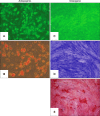Paracrine effects of adipose-derived stem cells on keratinocytes and dermal fibroblasts
- PMID: 22577262
- PMCID: PMC3346902
- DOI: 10.5021/ad.2012.24.2.136
Paracrine effects of adipose-derived stem cells on keratinocytes and dermal fibroblasts
Abstract
Background: Adipose-derived stem cells (ASCs) are mesenchymal stem cells that have recently been applied to tissue repair and regeneration. Keratinocytes and dermal fibroblasts play key roles in cutaneous wound healing.
Objective: We investigated the paracrine effects of ASCs on HaCaT cells (i.e., immortalized human keratinocytes) and human dermal fibroblasts to explore the mechanism of the effects of ASCs on cutaneous wound healing.
Methods: HaCaT cells and primary cultured human dermal fibroblasts were treated with 50% conditioned medium of ASCs (ASC-CM). Viability, in vitro wound healing, and fibroblast-populated collagen lattice contraction assays were conducted, and reverse transcription-polymerase chain reaction (RT-PCR) for the type I procollagen α1 chain gene was performed.
Results: The proliferation of HaCaT cells and fibroblasts was increased by ASC-CM in the viability assay. ASC-CM promoted in vitro wound healing of HaCaT cells and increased the contraction of the fibroblast-populated collagen lattice. RT-PCR showed that the transcription of the type I procollagen α1 chain gene in fibroblasts was upregulated by ASC-CM.
Conclusion: The stimulatory effect of ASC on cutaneous wound healing may be partially mediated by paracrine effects of ASCs on other skin cells. Application of ASCs or ASC-derived molecules could be an innovative therapeutic approach in the treatment of chronic wounds and other conditions.
Keywords: Adipose tissue; Fibroblasts; Keratinocytes; Mesenchymal stem cells; Wound healing.
Figures






References
-
- Steeper R. A critical review of the aetiology of diabetic neuropathic ulcers. J Wound Care. 2005;14:101–103. - PubMed
-
- Pittenger MF, Mackay AM, Beck SC, Jaiswal RK, Douglas R, Mosca JD, et al. Multilineage potential of adult human mesenchymal stem cells. Science. 1999;284:143–147. - PubMed
-
- Deng W, Obrocka M, Fischer I, Prockop DJ. In vitro differentiation of human marrow stromal cells into early progenitors of neural cells by conditions that increase intracellular cyclic AMP. Biochem Biophys Res Commun. 2001;282:148–152. - PubMed
-
- Fuchs S, Baffour R, Zhou YF, Shou M, Pierre A, Tio FO, et al. Transendocardial delivery of autologous bone marrow enhances collateral perfusion and regional function in pigs with chronic experimental myocardial ischemia. J Am Coll Cardiol. 2001;37:1726–1732. - PubMed
-
- Wu Y, Chen L, Scott PG, Tredget EE. Mesenchymal stem cells enhance wound healing through differentiation and angiogenesis. Stem Cells. 2007;25:2648–2659. - PubMed
LinkOut - more resources
Full Text Sources
Other Literature Sources
Miscellaneous

